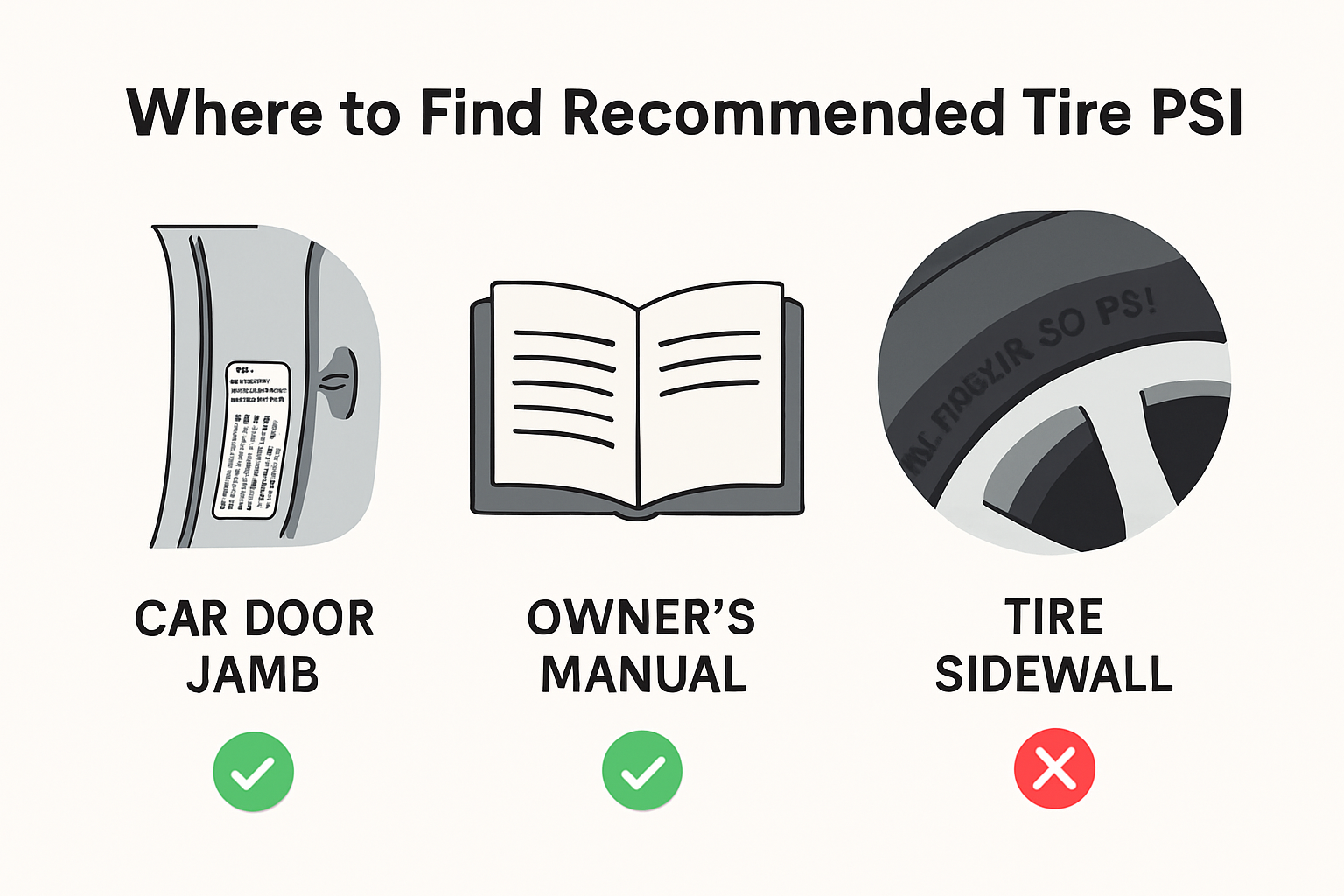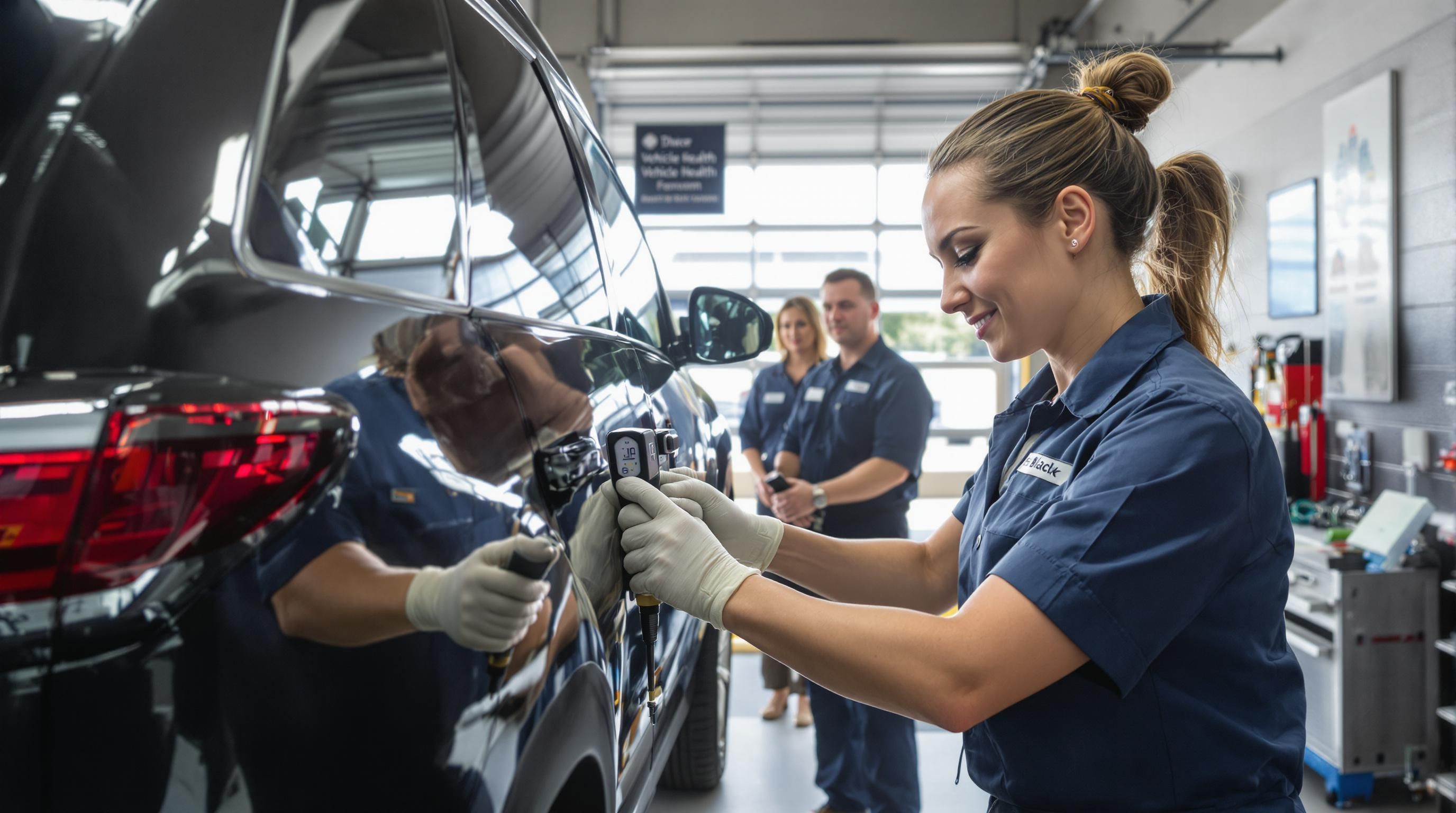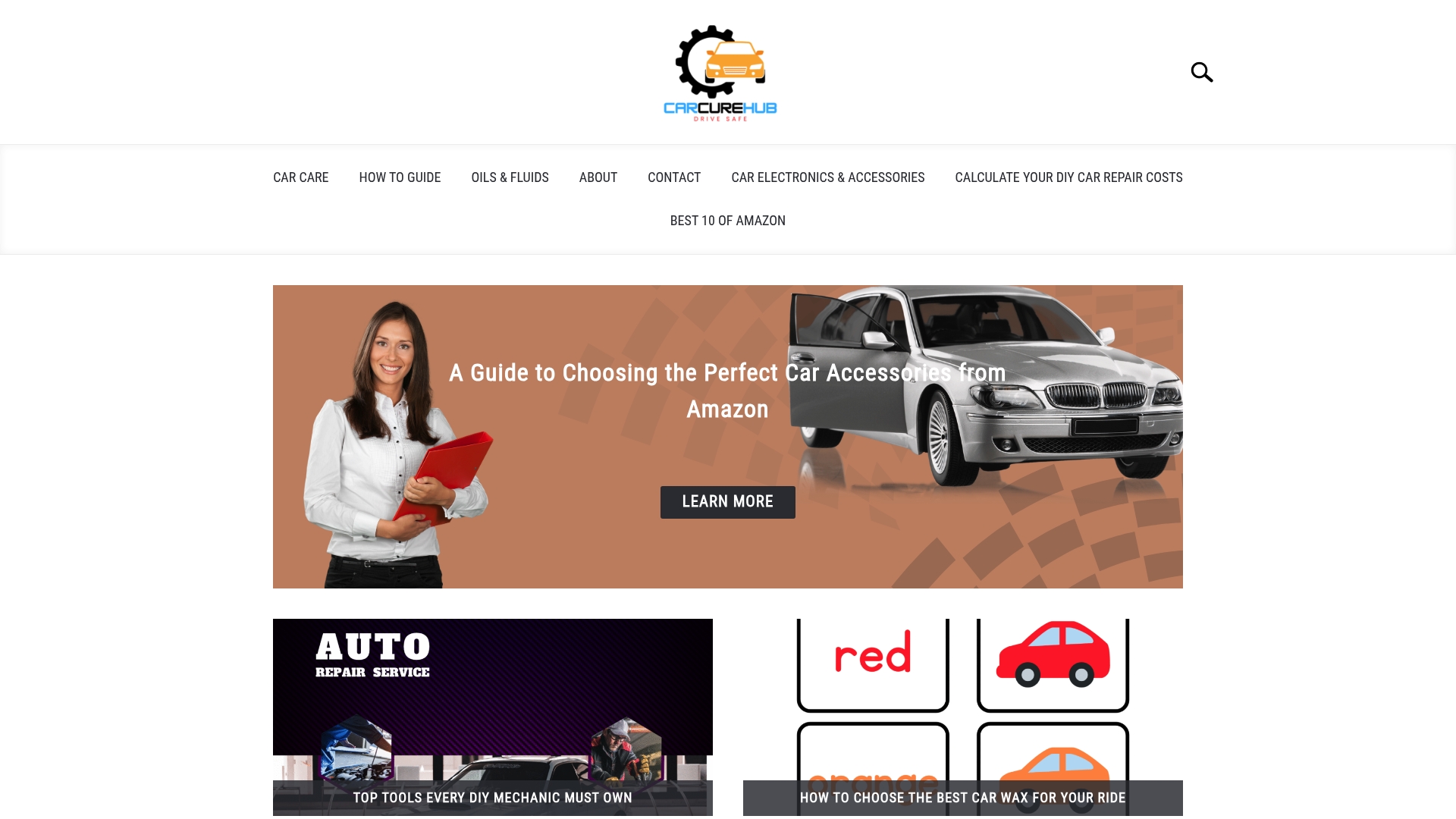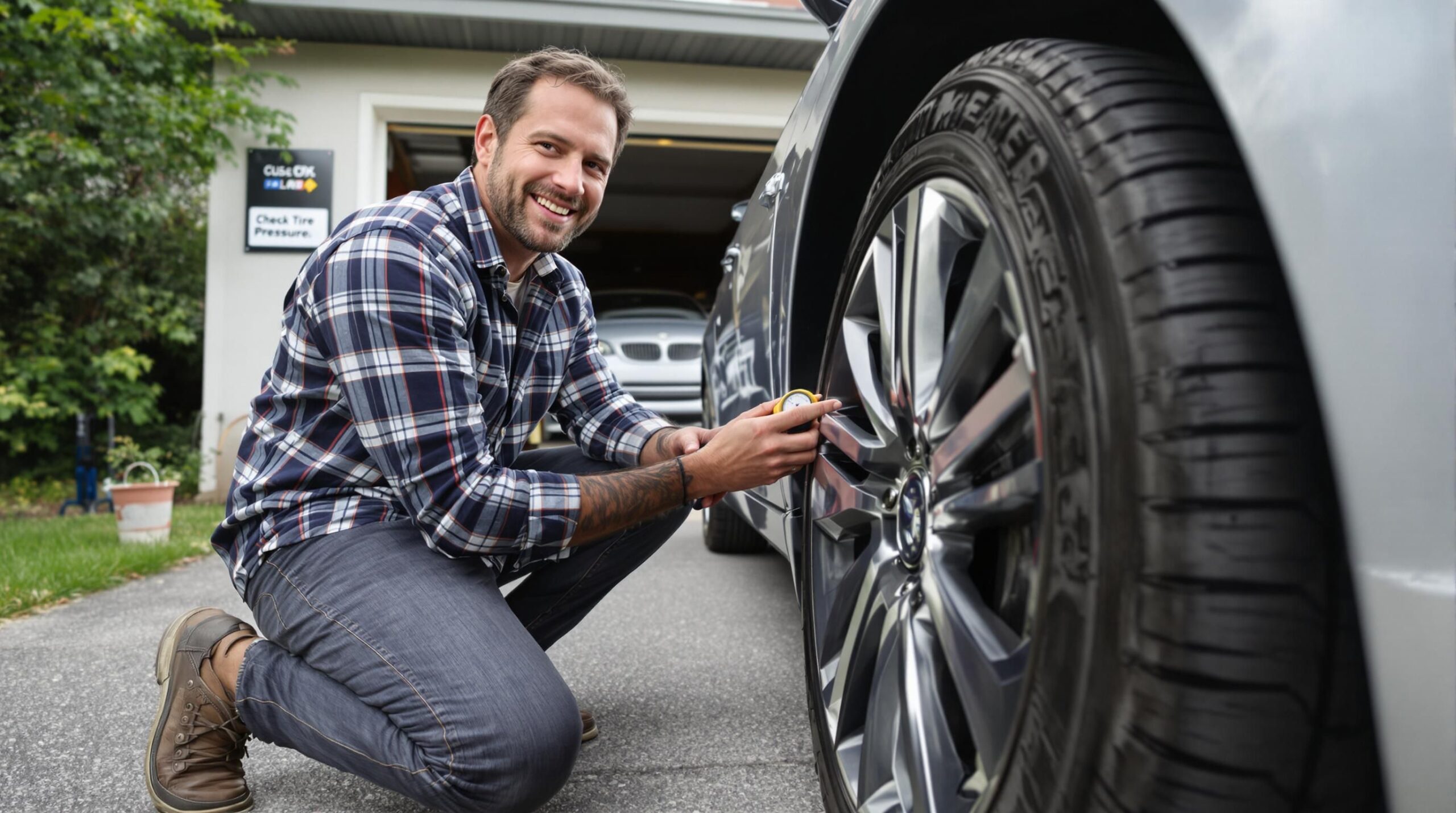Tire pressure might seem like a tiny detail in car maintenance, almost invisible compared to things like oil changes or brake checks. But here’s a shocker. Underinflated tires can slash your gas mileage by up to 3 percent and put you at real risk during emergency stops. Most people skip this basic check and end up paying more at the pump and risking their safety without even realizing it. The real trick? Checking your tire pressure only takes a couple minutes but delivers peace of mind every mile you drive.
Table of Contents
- Why Correct Tire Pressure Matters
- Finding Your Vehicle’s Recommended PSI
- How To Use A Tire Pressure Gauge
- Tips For Maintaining Proper Tire Pressure Year-Round
Quick Summary
| Takeaway | Explanation |
|---|---|
| Check tire pressure monthly. | Regular checks help ensure safety, performance, and fuel efficiency, minimizing risks of accidents and mechanical issues. |
| Know your vehicle’s recommended PSI. | Look for the tire pressure label on the driver’s side door or consult the owner’s manual to find optimal inflation values. |
| Use a reliable tire pressure gauge. | Choose between digital, analog, or dial gauges to regularly monitor tire pressure for more accurate readings and safety. |
| Adjust for seasonal temperature changes. | Tire pressure can drop or rise with temperature fluctuations, necessitating more frequent checks in extreme weather. |
| Maintain valve stem caps properly. | Always replace valve stem caps after checking to prevent dirt and moisture from damaging the valve and causing leaks. |
Why Correct Tire Pressure Matters
Tire pressure might seem like a minor detail, but it plays a critical role in your vehicle’s overall performance, safety, and efficiency. Most drivers overlook this simple maintenance task, yet it can significantly impact your driving experience and vehicle longevity.
Safety First: The Critical Connection Between Tire Pressure and Road Performance
Proper tire inflation is not just about maintaining your vehicle it’s about protecting yourself and others on the road. The Federal Highway Administration highlights that incorrect tire pressure can dramatically reduce vehicle traction, increasing the risk of accidents. Underinflated tires create a larger contact patch with the road, which sounds beneficial but actually reduces your ability to control the vehicle during sudden maneuvers or in emergency situations.
Underinflated tires are particularly dangerous during high-speed driving or in challenging weather conditions. They generate more heat, which accelerates tire wear and increases the likelihood of a blowout. A sudden tire failure at highway speeds can lead to catastrophic accidents, putting you and other drivers at significant risk.
Fuel Efficiency and Economic Impact
Beyond safety, tire pressure directly influences your vehicle’s fuel economy. When tires are not inflated to the manufacturer’s recommended PSI, your car must work harder to maintain speed and momentum. This increased resistance means your engine burns more fuel to compensate. According to automotive efficiency studies, maintaining proper tire pressure can improve gas mileage by up to 3%, which translates to meaningful savings over time.
Consider this: a set of consistently underinflated tires can reduce fuel efficiency and cost you hundreds of dollars annually in extra fuel expenses. Moreover, improper tire pressure accelerates tire wear, requiring more frequent replacements and adding to your overall vehicle maintenance costs.
Environmental and Long-Term Vehicle Health
Tire pressure is not just a personal economic issue it’s an environmental consideration. Vehicles with properly inflated tires produce fewer carbon emissions due to reduced rolling resistance. By maintaining correct tire pressure, you’re not only saving money but also contributing to reduced environmental impact.
Regular tire pressure checks also provide an opportunity to inspect your tires for other potential issues like uneven wear, punctures, or alignment problems. Learn more about comprehensive wheel maintenance to ensure your vehicle remains in optimal condition.
The bottom line is clear: checking and maintaining proper tire pressure is a simple yet powerful way to enhance your driving safety, save money, and extend the life of your vehicle. It takes just a few minutes and can prevent costly repairs, improve fuel efficiency, and provide peace of mind every time you hit the road.
Finding Your Vehicle’s Recommended PSI
Identifying the correct tire pressure for your vehicle is crucial for optimal performance and safety. Unlike a one-size-fits-all approach, tire pressure recommendations vary significantly depending on your specific vehicle make, model, and year.
Where to Find Your Vehicle’s Recommended Tire Pressure
The most reliable sources for your vehicle’s recommended PSI are readily available in multiple locations. The National Highway Traffic Safety Administration recommends checking three primary sources for accurate tire pressure information.
First, examine the driver’s side door jamb. Most vehicle manufacturers place a detailed tire information sticker here, which provides the exact recommended cold tire pressure for both front and rear tires. This sticker is typically located where the driver’s door meets the vehicle’s body and includes precise PSI recommendations for different load conditions.
If the door jamb sticker is missing or unreadable, your vehicle’s owner’s manual is the next definitive resource. The manual contains comprehensive information about tire specifications, including recommended inflation pressures for various driving conditions. Digital versions are often available online if you cannot locate the physical manual.
To help you quickly locate your vehicle’s recommended tire pressure, here’s a summary table of common sources and the information each provides:
| Source | What You’ll Find | Where to Look |
|---|---|---|
| Door Jamb Sticker | Recommended PSI for front and rear tires, load information | Driver’s side door jamb |
| Owner’s Manual | Detailed tire specs, PSI for various conditions | Glove compartment or online |
| Tire Sidewall Markings | Maximum safe tire pressure (not the recommended!) | Outer edge of tire |
| Digital/Professional Service | Vehicle-specific pressure recommendations, TPMS info | Service centers, onboard systems |
Understanding Tire Sidewall Markings
Tire sidewalls provide additional pressure information, but caution is necessary. Tire Rack explains that the maximum PSI listed on the tire sidewall is not the recommended driving pressure, but the maximum safe inflation pressure for that specific tire.
The sidewall maximum pressure is a safety limit, not an optimal driving specification. This number represents the absolute highest pressure the tire can safely hold under ideal conditions. Using this as your standard inflation pressure could lead to reduced vehicle handling, uneven tire wear, and potential safety risks.
Digital and Professional Resources for Precision
For vehicles with specialized configurations or aftermarket modifications, professional consultation becomes essential. Many automotive service centers offer free tire pressure checks and can provide precise recommendations tailored to your specific vehicle setup.
Modern vehicles equipped with Tire Pressure Monitoring Systems (TPMS) offer real-time pressure information. Read more about advanced tire maintenance techniques to understand how these systems can help you maintain optimal tire performance.
Remember that recommended tire pressures can differ between front and rear tires, and may change based on vehicle load. Always check pressures when tires are cold, typically before driving or at least three hours after driving, to get the most accurate reading.
Consistent and accurate tire pressure maintenance is not just about following numbers it’s about ensuring your vehicle’s safety, performance, and longevity. Take the time to understand your specific tire pressure requirements and make checking them a regular part of your vehicle maintenance routine.

How to Use a Tire Pressure Gauge
Using a tire pressure gauge is a straightforward yet critical skill for every vehicle owner. With multiple types of gauges available, understanding how to use them correctly can make a significant difference in maintaining your vehicle’s performance and safety.
Types of Tire Pressure Gauges
Tire pressure gauges come in three primary varieties: digital, analog (pencil), and dial gauges. Pima County’s Vehicle Maintenance Guide recommends understanding the pros and cons of each type before making a selection.
Digital gauges provide the most precise readings with clear, easy-to-read electronic displays. They are typically more expensive but offer high accuracy and are ideal for those who prioritize exact measurements. Analog or pencil gauges are the most traditional and budget-friendly option. These compact tools extend when pressure is applied to the valve stem, showing the PSI reading on a graduated scale. Dial gauges feature a larger, more prominent display with a circular gauge, making them easier to read for individuals with vision challenges.
Below is a comparison table highlighting the key features, pros, and cons of the three main types of tire pressure gauges discussed above:
| Type of Gauge | Key Features | Pros | Cons |
|---|---|---|---|
| Digital | Electronic display, battery powered | Most accurate, easy-to-read | More expensive, need batteries |
| Analog (Pencil) | Mechanical, stick reads PSI | Inexpensive, compact, reliable | Harder to read, less precise |
| Dial | Circular face, larger display | Easy-to-read, good for vision issues | Bulkier, can be more expensive |
Step-by-Step Tire Pressure Checking Process
NJM Insurance Group provides a comprehensive guide for accurately checking tire pressure. Begin by ensuring your tires are cold, which means the vehicle has been stationary for at least three hours or driven less than a mile. This ensures the most accurate reading, as tire pressure increases with heat and driving.
Remove the valve stem cap and keep it in a safe place. Press the tire pressure gauge firmly and squarely onto the valve stem. Ensure a tight seal to prevent air from escaping during measurement. For digital gauges, the reading will appear almost instantly. With analog gauges, the measurement stick will pop out, indicating the current pressure. Compare the reading to your vehicle’s recommended PSI, which can be found on the driver’s side door jamb or in the owner’s manual.
Common Mistakes and Pro Tips
GEICO’s automotive experts highlight several common mistakes to avoid. Never rely solely on visual inspection, as tire pressure cannot be accurately determined by looking at the tire. Underinflated tires can appear normal but compromise vehicle safety and performance.
Check your tire pressure monthly and before long trips. Temperature changes can significantly impact tire pressure fluctuations. In winter, tire pressure can drop approximately 1 PSI for every 10-degree Fahrenheit temperature decrease. Learn more about advanced tire maintenance techniques to ensure consistent performance.
Always replace the valve stem cap after checking pressure. These caps help prevent dirt and moisture from entering the valve stem, which can cause air leaks or valve damage. When adding air, do so in small increments and recheck the pressure to avoid overinflation.
Mastering the use of a tire pressure gauge is an essential skill for responsible vehicle ownership. By investing a few minutes each month to check and maintain proper tire inflation, you can improve your vehicle’s safety, fuel efficiency, and overall performance. Remember, consistent maintenance is key to extending the life of your tires and ensuring a smooth, safe driving experience.
Tips for Maintaining Proper Tire Pressure Year-Round
Maintaining consistent tire pressure is a year-round commitment that requires attention to changing environmental conditions and driving habits. The U.S. Tire Manufacturers Association emphasizes that proper tire maintenance is crucial for vehicle safety, performance, and longevity.
Seasonal Pressure Variations and Strategies
Temperature plays a significant role in tire pressure fluctuations. For every 10-degree Fahrenheit change in ambient temperature, tire pressure can shift by approximately 1 PSI. This means winter’s cold temperatures can cause tire pressure to drop dramatically, while summer’s heat can cause pressure to increase.
In winter, tire pressure tends to decrease more rapidly. Cold air becomes denser, causing the air molecules in your tires to contract and reduce overall pressure. Tire experts recommend checking tire pressure more frequently during colder months, ideally every two weeks. Conversely, summer’s heat can cause tire pressure to increase, potentially leading to overinflation and uneven wear.
Here’s a summary of how temperature changes can impact tire pressure throughout the seasons:
| Season | Typical Temperature Change | Effect on Tire Pressure | Recommended Action |
|---|---|---|---|
| Winter | Colder (10°F drop = ~-1 PSI) | Pressure decreases | Check pressure more frequently (biweekly) |
| Summer | Warmer (temps can spike) | Pressure increases | Watch for overinflation; check monthly |
| Seasonal Swings | Rapid weather transitions | Pressure fluctuates | Check before/after major weather changes |
Advanced Maintenance Techniques
Beyond regular pressure checks, several advanced techniques can help maintain optimal tire performance. Explore comprehensive wheel maintenance strategies to ensure your vehicle remains in top condition throughout the year.
Invest in a reliable digital tire pressure gauge that provides accurate readings across temperature ranges. Some modern tire pressure monitoring systems (TPMS) can alert you to pressure changes in real-time, providing an additional layer of protection against potential tire-related issues.
Pay special attention to your vehicle’s tire pressure when transitioning between seasons. A sudden temperature swing can cause significant pressure changes that might go unnoticed without regular monitoring. Before long trips or significant temperature changes, always perform a comprehensive tire pressure check.
Environmental and Performance Considerations
Proper tire maintenance extends beyond personal convenience it’s an environmental responsibility. The New York State Department of Environmental Conservation notes that maintaining correct tire pressure can improve fuel efficiency, reduce tire wear, and minimize waste.
Underinflated tires increase rolling resistance, forcing your engine to work harder and consume more fuel. This not only increases your vehicle’s carbon footprint but also leads to higher fuel costs. Overinflated tires can cause uneven wear, reducing tire lifespan and potentially compromising vehicle handling and safety.
Consider creating a tire maintenance schedule. Set reminders on your phone or calendar to check tire pressure monthly, before long trips, and during significant seasonal transitions. Keep a reliable tire pressure gauge in your vehicle and learn to use it confidently.
Remember that tire pressure is just one aspect of comprehensive vehicle maintenance. Regular rotation, alignment checks, and visual inspections can help identify potential issues before they become serious problems. By dedicating a few minutes each month to tire pressure maintenance, you can improve your vehicle’s performance, safety, and efficiency while potentially saving hundreds of dollars in fuel and premature tire replacement costs.

Frequently Asked Questions
How often should I check my tire pressure?
You should check your tire pressure at least once a month and before long trips to ensure optimal safety and performance.
Where can I find my vehicle’s recommended tire pressure?
The recommended tire pressure can be found on a sticker located on the driver’s side door jamb, in your owner’s manual, or on the tire sidewall.
How do I use a tire pressure gauge?
To use a tire pressure gauge, remove the valve stem cap from the tire, press the gauge onto the valve stem firmly, and read the PSI displayed on the gauge.
What can cause tire pressure to fluctuate?
Tire pressure can fluctuate due to temperature changes, typically dropping in colder weather and increasing in warmer conditions. It’s essential to check pressure regularly during seasonal transitions.
Ready to Take Control of Your Tire Safety and Save Money?
If you have ever worried about unsafe road conditions or felt frustrated by rising fuel costs, you know the consequences of skipping simple tasks like checking your tire pressure. Underinflated tires can lead to blowouts, wasted fuel, and increased tire wear. Consistent checks are the easiest way to drive safely and avoid expensive repairs. But knowing the right tools and techniques—or where to find reliable maintenance tips—makes all the difference.

Discover easy step-by-step guides, real product recommendations, and trusted advice tailored for every USA car owner at CarCureHub. Start with our practical guide to wheel and tire assembly care for deeper maintenance tips or find out how the right manual air pump for car tires can help you keep your pressure consistent year-round. Do not wait until you lose control or see tire warning lights. Visit CarCureHub today and stay confident on every trip.
Recommended
- How to Use a Tire Pressure Gauge: Expert Tips – Car Cure Hub
- Wheel Tire Assembly: Enhance Performance & Safety – Car Cure Hub
- Car Cure Hub – Fix It Fast, Drive with Confidence
- Essential Maintenance Tips for First-Time Car Owners – Car Cure Hub
Article generated by BabyLoveGrowth
Recent Posts
Cold-Weather Driving Essentials: Top Gloves for Safe Winter Travel
Keep your hands warm and your steering wheel secure this winter with our top glove picks. Discover the best options for safe and comfortable cold-weather driving!
Tesla Roof Rack Storage: Ultimate Guide to Secure and Versatile Cargo Solutions
Tesla roof rack storage offers extra space to carry luggage and gear securely on your Model Y. These racks fit various needs, from bikes to kayaks, making travel easier. ...


